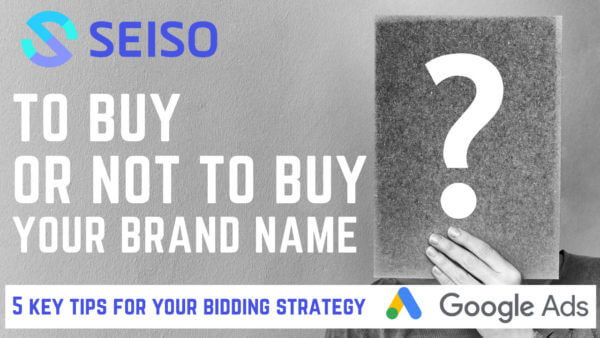The brand name conundrum: to buy or not to buy (your brand name)?
This is a question as old as the business: is there any point in buying one’s own brand in Google Ads? Or should I leave that to SEO?
It almost comes down to philosophical questions:
- Why pay for traffic while I am ranking in the number one position on organic results?
- Will my Adwords ads on my brand keyword have an impact on my organic traffic?
- Why buy my own brand terms, and give money to Google for traffic I am the only legitimate destination for?
TLDR; Yes, you should bid on your brand keyword… but you need to follow a few basic rules to make it work for you.
Now let’s go through this step by step: why should you, how to do it efficiently, how to defend from too aggressive competitors and how to replicate.
Why should I give money to Google? I am already in first position.
1. Maximize your share of voice
Bidding on branded queries helps you prevail on search engine result pages (SERPs). Like CPG brands pay to get extra shelf space at Walmart to increase their purchase intent. Owning more shares of voice on SERP will help you drive more traffic and sales.
Moreover, if you combine your PPC ads, local pages, product images, and an efficient SEO campaign then you can occupy most of the SERP.
These pages are yours to own: when someone’s looking for your brand, you don’t want to leave space to competition. You need to own the space to position yourself as the leading player.
If you want to analyze your share of voice on key terms, you can use a Google Ads analyzer such as Seiso, and it’s free to try.
2. Control your image
Yes, organic links are free, but they are generic and you don’t have full control over how Google will display them. The benefit of sponsored links is that you can choose how to present yourself and not be limited by what helps your organic ranking.
PPC ads give you the opportunity to :
- Create eye-catching copywriting in your ad text
- Choose the landing page you want to use
- Choose the USPs to highlight in your extensions
- Choose the site links to be highlighted
Additionally, this is also an opportunity to display the five stars of the Seller ratings extensions next to your brand.
3. Defend your brand
Competition may already be buying your brand name. When the user searches for your brand and sees your competition ads in the top results, this is bad. This is where they might learn about them and their claims compared to yours. There is a high risk of missing opportunities because:
- You are not sure the user will make the effort to come back to your website afterward.
- Some companies will direct this traffic to specific landing pages offering comparison charts. They will compare their offering to yours and of course show why they are a better alternative. This battle is not always played fairly.
Saas comparison websites such as Capterra and G2crowd have built a large part of their traffic acquisition strategy on the “alternative to” keyword space. You need to occupy this space and own the narrative.
How to buy brand terms for less?
Now, we know you need to own this space, but this does not mean you need to spend blindly on your brand terms campaigns. You need to focus on two things.
1. Avoid wasted spend
You need to segregate your traffic. Not all queries, including your brand name, bring new business. First, isolate negative terms such as “scam,” “fraud,” and exclude them from your campaign. Even better, buy them and redirect them to a specific page addressing the issues, offering positive reviews and customer support options.
Then, you’ll need to isolate terms that are not useful for your acquisition strategy: “Guarantee,” “Connect,” “lost password,” “promo coupon,” etc. Those are terms your competition or third parties will position themselves on and are not easy to get listed on through SEO. Yet it is key for you to be listed there.
2. Split brand vs non brand performance in your reports
Brand-related traffic will not behave like generic traffic. CTR is likely to be much higher as people who search for your brand name will be more likely to click on your ads. You need to split your reports and set specific budgets and profitability targets. You also need to split targets and KPIs for market share targets.
As a good market practice, you should aim for at least 90% of impression share for your brand keywords. This means that nine times out of 10, your ad will be displayed when a user is looking for you.
For generic keywords, 80% of impression share is enough, but as always, this should be monitored with regards to your ROI targets.
SEISO can help you understand where you stand in three clicks. Sign up for a free trial and get your Google ads insight report, including share of voice.
Example of PPC Diagnosis for Brand / Non-Brand traffic by SEISO
What should you do when your competitor is buying your brand?
1. Find the competitors bidding on your brand
There is a way in the Google Ads interface to identify who is bidding on your own brand terms.
- Go to your brand campaign. If you have followed our advice so far, you should have one already.
- Select “Auction Insights,” and you will then have access to the impression share of your competitors on your own brand.
Some tools or scripts can help you to raise alerts when advertisers purchase a brand keyword. It will help you to monitor it across multiple networks and geographies automatically.
2. Bid on your brand name
To quickly offset their campaign, you should start to buy your brand immediately. Buying your brand is not expensive because you will have a high-quality score: you are the most relevant on the request, so your CTR should be high. Moreover, even if a competitor is buying the term, the term’s competition should be rather limited.
By bidding on your brand term, you create a barrier to entry for competitors who will be given a malus on their Quality Score. They will have to pay dissuasive prices on their cost per click to challenge your position.
3. Contact Google to protect your trademark
You can also try to protect your brand name with a direct request to Google. Just fill the Google Ads Trademark Complaint form. Depending on your brand name and country, Google will be willing to block your competition. Be aware, like any legal process, this is not always very swift.
4. Make a deal
Your competitor may not be aware that he is bidding on your brand keywords! The purchase of a competitor’s brand name in its keyword bids can be done unintentionally, especially in Smart Campaigns or Dynamic Search Ads.
Just talk to them! Contact your competitor who buys your brand name directly and ask them to stop. They simply need to add your name as a negative keyword in their interface.
Why would they want to stop? This is the conversation you need to have, but they will understand that if they buy your brand terms, you might as well do the same to them.
It’s always better to find an agreeable solution whenever possible.
Does this mean you can buy your competitor’s brand term as a keyword on Google?
Yes you can, but as we just saw, it is not that easy. It depends on the industry you are in:
- What are the existing competitive practices?
- What are the relationships between the different companies in the sector?
- Have they protected their terms?
As a rule of thumb, if they can buy yours, you should be able to buy theirs.
As a reminder, it is forbidden by the Google Ads policies to mention the name of the competitor’s brand in your ad text.
Beyond the uncomfortable notion of paying Google to appear on its own brand, the key takeaway here is that it makes sense to buy your own brand keywords on Google Ads.
However, it must be done thoughtfully:
- Specific copywriting and ad groups
- Specific labels for brand campaigns and a dedicated report
- Specific targets and KPI’s for brand and non-brand impression shares
- Monitor competitors’ impression shares on your own brand keyword.
For more tips and insights on your Google Ads accounts, test the SEISO campaign optimization tool for free: www.seiso.io/en



